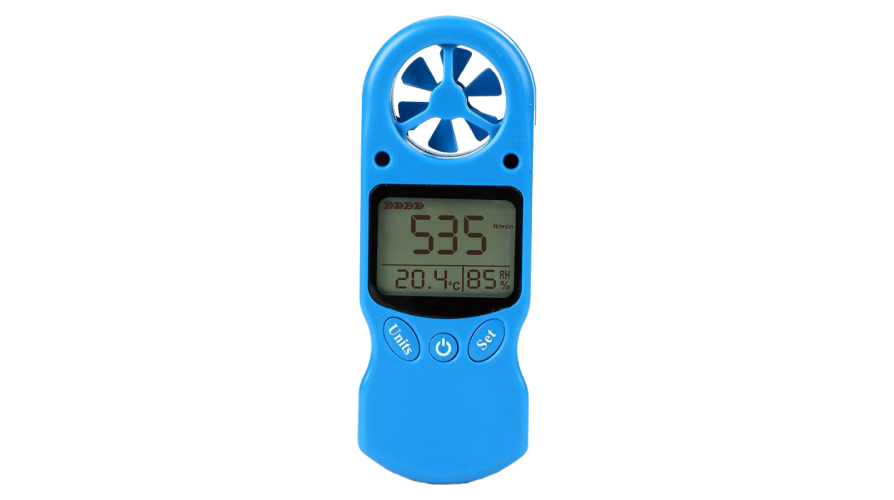All You Need to Know About Anemometers: Just How They Work, Why They Matter, and Where to Utilize Them
Anemometers, though frequently neglected in the realm of scientific tools, play an important function in numerous areas, offering beneficial insights into wind speed and airflow patterns. As we dig right into the intricacies of anemometer modern technology, we will certainly reveal the inner operations of these devices, their relevance, and the essential considerations when selecting the best anemometer for certain applications.

Anemometer Essentials
A vital instrument utilized to gauge wind speed and instructions, the anemometer plays a critical role in meteorology and numerous sectors. An anemometer usually is composed of 3 or 4 mugs that revolve in the wind, a vane that directs into the wind, and sensors to track the rotations or activities. By calculating the rotations or movements over a particular time period, the anemometer can identify wind speed. The vane helps determine wind direction by pointing right into the wind, offering important information for weather forecasting, aviation, maritime procedures, ecological tracking, and wind power applications.
There are numerous sorts of anemometers available, including mug anemometers, vane anemometers, hot-wire anemometers, and sonic anemometers, each with its one-of-a-kind functions and applications. Mug anemometers are frequently utilized for fundamental wind speed dimensions, while vane anemometers are preferred for directional dimensions. Hot-wire anemometers are ideal for reduced airspeeds, and sonic anemometers are suitable for high-precision dimensions in study and commercial settings. Recognizing the fundamentals of anemometers is essential for exact wind information collection and analysis throughout different fields.
Principles of Anemometer Procedure
Building on the fundamental understanding of anemometer essentials, the principles of anemometer procedure elucidate the technicians behind wind speed and instructions measurements. Anemometers run on the concept of air movement affecting a sensing unit, creating it to turn. Mug anemometers, for instance, have three or more mugs that record the wind, creating them to rotate quicker as the wind speed boosts. The turning rate is then converted right into a wind rate dimension. Vane anemometers, on the other hand, use a tail or a probe that straightens itself with the wind instructions, giving a measurement of wind instructions based on the orientation of the sensor. Hot-wire anemometers depend on a warmed wire that cools as wind passes over it, with the rate of cooling establishing the wind speed. Ultrasonic anemometers procedure wind rate and direction by examining the moment it takes for ultrasonic signals to take a trip in between transducers. Recognizing these concepts is crucial for exact and reliable wind measurements in various applications.
Relevance of Anemometers
The importance of anemometers in meteorology and various markets can not be overemphasized. Anemometers play a critical role in gauging wind speed and instructions, giving crucial information for weather projecting, climate research studies, environmental tracking, and air travel operations. Meteorologists rely upon anemometers to collect accurate wind data, aiding them comprehend climate patterns, predict storms, and issue prompt cautions to the general public. In sectors such as building and construction, agriculture, renewable power, and maritime procedures, anemometers are used to optimize procedures, make sure safety, and raise efficiency. Wind farm drivers use anemometers to assess wind conditions and make the most of power production from wind generators. In the maritime market, anemometers aid ship navigation by giving real-time wind details to captains, helping them make informed decisions to make certain risk-free trips. Generally, anemometers are important tools that contribute significantly to security, efficiency, and informed decision-making in meteorology and a wide variety of sectors.
Applications Across Various Industries
Applications of anemometers cover throughout varied markets, showcasing their adaptability and energy past meteorology. In the eco-friendly energy industry, anemometers play a vital role in assessing wind problems find more info for wind farm positionings, guaranteeing optimal power production. Industries like construction and mining use anemometers to keep track of wind speeds, essential for safety methods, especially when working at heights or in open-pit mines where solid winds can posture risks. Anemometers are likewise indispensable in the aeronautics industry, helping pilots in understanding airspeed Get the facts and wind direction for safe take-offs and landings. The maritime field gain from anemometers for ship navigating, aiding sailors prepare for weather changes and change paths as necessary. In agriculture, anemometers help farmers in managing plant spraying by providing real-time data on wind speed to prevent drift. Anemometers locate applications in A/c systems to optimize air flow and improve power efficiency in structures. The varied usage situations of anemometers underscore their value across different industries, highlighting their crucial duty in improving operational safety and effectiveness (anemometer).

Selecting the Right Anemometer for Your Needs
Selecting the proper anemometer tailored to your details needs is crucial for obtaining accurate wind speed and instructions measurements. When selecting an anemometer, think about variables such as the designated application, required measurement array, ecological problems, and wanted features. For general functions, a mug anemometer is appropriate for determining wind rate, while a vane anemometer gives wind direction data. Hot-wire anemometers are ideal for low airspeed measurements, and ultrasonic anemometers offer high accuracy and resilience.

Conclusion
In verdict, anemometers play a critical function in gauging wind speed and direction across various sectors. It is vital to think about the value of anemometers in order to make informed choices when picking the most ideal gadget for determining wind conditions.
There are various types of anemometers available, including mug anemometers, vane anemometers, hot-wire anemometers, and sonic anemometers, each with its unique functions and applications. Mug anemometers are typically utilized for my link basic wind rate dimensions, while vane anemometers are liked for directional dimensions. Hot-wire anemometers are suitable for low airspeeds, and sonic anemometers are suitable for high-precision dimensions in research and commercial setups.Building on the foundational understanding of anemometer basics, the concepts of anemometer operation illuminate the technicians behind wind rate and direction measurements. For general functions, a cup anemometer is ideal for gauging wind rate, while a vane anemometer supplies wind direction data.